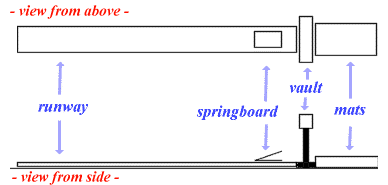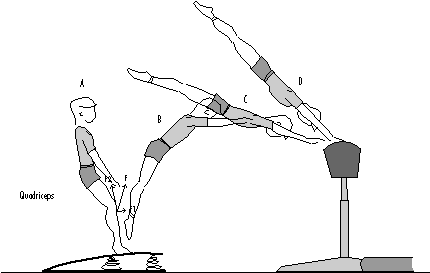


 The vault event in gymnastics is
the quickest event in gymnastics. Both men and women do the vault event.
Before, the horse for men is placed vertically while for women, the horse is
place horizontally. Now, gymnastics uses a safer vaulting platform, used
by men and women. The basic skill for vault is
the front handspring. It involves speed, quickness, and explosive power. The
basic sequence of the vault is a strong, accelerated run, a hurdle to the
springboard, the critical takeoff from the board, a turn over from the board to
the horse, and finally, repulsion, from the horse. The front handspring vault
has several variations in the postflight phase. The simplest is to for the
gymnast to go right to the landing without any intermediate twists or flips. The
animation above, for example, shows a front handspring with a full twist at the
end. However, the basic physics principles involved are the same.
The vault event in gymnastics is
the quickest event in gymnastics. Both men and women do the vault event.
Before, the horse for men is placed vertically while for women, the horse is
place horizontally. Now, gymnastics uses a safer vaulting platform, used
by men and women. The basic skill for vault is
the front handspring. It involves speed, quickness, and explosive power. The
basic sequence of the vault is a strong, accelerated run, a hurdle to the
springboard, the critical takeoff from the board, a turn over from the board to
the horse, and finally, repulsion, from the horse. The front handspring vault
has several variations in the postflight phase. The simplest is to for the
gymnast to go right to the landing without any intermediate twists or flips. The
animation above, for example, shows a front handspring with a full twist at the
end. However, the basic physics principles involved are the same.

The Preflight to Take-off
After an accelerated run, the gymnast takes a hurdle step onto the spring board. An arm circle is used to further maximize the force it takes to turnover onto the horse. The run is usually about 25 meters, and the run represents translational motion. We can thus calculate the kinetic energy the gymnast possesses during the run with KE = (1/2) mv2, where 'm' is the mass of the gymnast and 'v' is the velocity of the run. The kinetic energy is transferred to potential energy upon compression of the springboard where PEelastic=1/2 kx2, where 'k' represents specific spring constant and 'x' is the deplacement of the spring from its equilibrium position. Gymnasts are taught to have a good "punch" off the spring board, thus increasing the displacement and increasing the potential energy. In the diagram at the left, A, represents the compression of the springboard. The vector of forces are labled. B, C, and D are the phases of the take-off. An examination in the biomechanics of this phase is important. The total vault is highly dependent upon increasing the magnitude of the angular force component at takeoff. The net force produced by the quadriceps during extension of the knee joint can be improved by the place ment of the patella. The patella has the ability to change the angle of quadriceps insertion in the tibia. By increasing the angle of insertion, more of the total amount of force produced by the quadriceps muscle can be directed along the angular component, resulting in improved torque for a powerful and effective take off.
The Postflight
The posflight phase of the front handspring vault is critical. It is the takeoff from the horse. Gymnasts are often told to "pop" off the horse, using the shoulders to gain maximum "spring" from the horse. Thus, in a sense, the gymnast's shoulders act like a spring, further increasing the potential energy to initiate twists and/or flips or simply just have a good landing. During this part of the vault, the gymnast has both translational and rotational kinetic as well as gravitational potential energies. The translational component can be looked at independently of the rotional component because the rotation does not affect it. The gymnast flies through the air and her hips (center of mass) trace a parabolic path characteristic of projectile motion. The gymnast leaves the vault with a velocity directed upward. This is the initial velocity. The downward acceleration due to gravity acts on the gymnast to cause her height to decrease and finally for her to land. In postflight a gymnast tries to acheive maximum height as well as horizontal distance travelled. This can be done by changing the angle with which the initial velocity is directed; the angle that the gymnast leaves the horse with.